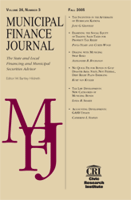Complete Issue
Author: Rodney V. Hissong.
Source: Volume 22, Number 01, Spring 2001 , pp.1-100(100)

< previous article |return to table of contents
Abstract:
This issue of the Municipal Finance Journal contains a tax increment finance (TIF) symposium. Five authors evaluate TIF from five different cities and states. Local governments commonly use TIF to promote economic development. Generally, TIF involves using property tax revenue from incremental property values, within a designated zone, to retire debt incurred for capital improvements within the TIF zone. TIF was first introduced as an economic development technique for blighted areas. Municipal governments and overlapping jurisdictions were willing to forego additional tax revenues over the life of the bonds in exchange for development in an area not otherwise likely to experience economic development. Initially, it was held the property owners in the zone paid the taxes and thus they were paying the costs for improvements for which they were the primary beneficiaries. It also meant municipalities avoided bearing the full costs of renovating the infrastructure. Scholars have long debated the merits of this financial arrangement for local economic development. Who actually bears the burden of TIF is at the core of the debate. Some argue property owners outside the TIF zone subsidize property owners inside the TIF zone. Another dimension in the debate is the use of TIF in nonblighted areas. Others question the net effect of TIF zones and believe TIF produces zero net effects when considering labor and capital mobility. The TIF symposium in this issue contributes to multiple facets of the debate surrounding the effectiveness of TIF. Five authors pose numerous hypotheses and use a variety of research methodologies to test them. As a group they test for economic viability and the impact TIF has inside and outside the TIF zone. The units of analysis in four of the papers are particular projects in four distinctly different cities: Barberton, Ohio; Kirksville, Missouri; Minneapolis, Minnesota; and Pittsburgh, Pennsylvania. The fifth paper explores factors at the city level in Maine.Keywords:
Affiliations:
1: University of Texas at Arlington.